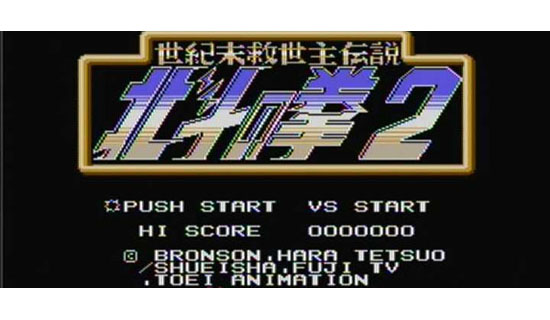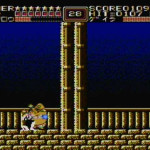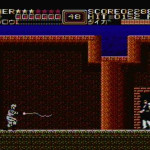Marking the third Hokuto no Ken game released in a single year’s time, Hokuto no Ken 2 is a followup to the first Shouei System developed game on the Famicom. Not only did the inferior of the two Hokuto no Ken games get the sequel in this case (the more deserving one being the Master System/Mark II game), but this one is also based on the second half of the series (taking place several years after Raoh’s defeat). Popular opinion is that the second half was a mere shadow of the first, with weaker supporting characters and a far less engaging story. It also bears the same subtitle that the anime adaptation of Hokuto no Ken did from the beginning: “seikimatsu kyuuseishu densetsu” (“Legend of the Century’s End Savior”). On top of getting a raw deal in terms of the source material, Hokuto no Ken 2 also had the misfortune of being released on the exact same day as the Famicom port of a genre-evolving beat-em-up: Nekketsu Kouha Kunio kun (Renegade). It’s no wonder that these early Hokuto no Ken games have been largely forgotten.
Yet this sequel is more playable and better designed than its Famicom predecessor. The graphics have been brought up to the actual standards of early Famicom titles, and mostly gone is the ridiculous idea of having to go through a series of doors in the correct order to progress. The control scheme and power-up system remain largely the same as the first game, with some minor additions. Along with the power-up that is literally just three characters reading “abeshi”, we now get a “hidebu” one as well (“hidebu!!” being the sound that Heart made as he died an exploding and bloody death at the hands of Kenshiro). “abeshi” is used as it was previously, to increment the number of stars Kenshiro has in order to upgrade his move-set. Additionally, a fireball can now be launched when fully powered-up (which is achieved by getting 10 stars this time around, not 7) by pressing both A and B. “hidebu” is specifically used to upgrade Kenshi’s movement speed. Necklaces that result in a mirror image of Kenshiro appearing can also be picked up, temporarily absorbing any damage dealt to him. Power-ups seem slightly easier to get now, though perhaps that just comes with this being a better game.
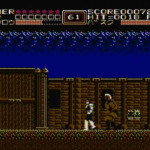 | 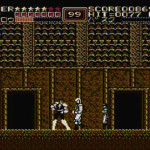 |
| Bask, looking like an 8-bit interpretation of Birdie from the Street Fighter series | Various characters sometimes appear after a boss battle, such as useless adult Bart and Lin! |
The level design is easily the most standout improvement, though there was no where to go but up from the neon-colored skies and flat landscapesof the previous Famicom title. Pits and staircases introduce the element of multiple-floors to some levels, along with various obstacles such as needing to break blocks to advance through one particular level. If only the same good sense would have been applied to removing the many bottles (replacing the knives that did the same thing in the previous game) that randomly fly at you from off-screen, often in nearly impossible to dodge patterns. Also back is the Hokuto no Ken staple of having to know specifically where to hit a boss in order to significantly damage them. While this doesn’t apply to every single boss, and a good number of them you can just whittle down through carefully planned standard attacks, some are practically impossible without knowing exactly where to hit them. As I’ve stated previously, this is an interesting mechanic for die hard fans of the series, but it ultimately ends up making the game too obtuse for the average player.
Replacing the alternating 2-player mode of the previous Hokuto no Ken title is a VS mode. This is similar to the secret boss-rush mode found in the Master System/Mark III Hokuto no Ken game, in that you get a single life to run through each level’s end boss. This proves to be a good way to practice boss strategies, and is actually an easier way of beating them since your life is refilled fully before each new boss.
Unlike the Master System/Mark III Hokuto no Ken game, this one was brought to the US under its rightful name and license: Fist of the North Star. And as with many Japanese games that were brought overseas at this time, several adjustments were made. The Black clothing of Kenshiro’s sprite was altered to blue, immediately bringing to mind the hideous blue sprite from the first Famicom game that never made it over, though it was probably done to make the sprite appear more true to Kenshiro’s anime representation. The graphics have been generally brightened up and slightly sharpened, giving them a much less dingy look than the original. The difficulty was also considerably lowered in a couple of different ways: Bosses no longer needed to be attacked in such specific ways in order to cause significant damage to them, and the random off-screen bottle projectiles were removed completely. So why did the US end up getting this game on the NES, but not the first one? Given that the US release date was two full years after the Japanese release, the first title would simply not have been an option. This one would seem dated enough by 1989 NES standards, to say nothing of the first game which looked dated immediately upon release. And in terms of quality, we can really just forget that the first game exists at this point.
While this sequel was a step in the right direction, gaming was just too immature to be able to create a truly satisfying Hokuto no Ken beat-em-up experience at this point. Perhaps others had this same realization, given that after the next game in the franchise Hokuto no Ken games would take a long vacation from the genre. While beat-em-ups would would rapidly evolve from here, Hokuto no Ken games would follow the popular gaming trends of the times and largely be made to suffer for it. If you desperately want to experience this insignificant piece of history, you’ll need to pick up some version of the original cartridge. Like its immediate predecessor, this title can’t be found on Virtual Console or any other download service.
